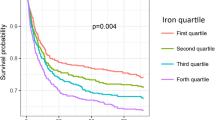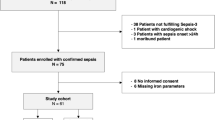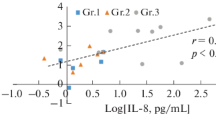Abstract
Objective
To determine serum bleomycin-detectable ‘free’ iron in patients with septic shock and to relate these findings to both outcome and a marker of free radical damage.
Design
A prospective observational study.
Setting
A nine-bed intensive care unit in a university teaching hospital.
Patients
Sixteen consecutive patients with septic shock, defined as: (1) Clinical evidence of acute infection; (2) hypo- or hyperthermia (<35.6° or >38.3°C); (3) tachypnoea (>20 breaths/min or ventilated); (4) tachycardia (>90 beats min); (5) shock (systolic pressure <90 mmHg) or on inotropes. Fourteen patients also had secondary organ dysfunction.
Measurements and results
Bleomycin-detectable iron concentrations were elevated in all patients (37.2±11.0 μmol/l vs 5.1±3.3 μmol/l in healthy subjects,P<0.0001), but there was no difference between patients who died and those who survived (39.2±9.3 and 36.2±12.3 μmol/l, respectively). Thiobarbituric acid reactive substances 9an index of lipid peroxidation) were higher in those who died (3.33±2.29 μmol/l) than in the surviving patients (0.99±0.14 μmol/l,P<0.01) or healthy subjects (0.92±0.39 μmol/l,P<0.01). Free iron did not correlate with thiobarbituric acid-reactive substances. However, a significant correlation was found between lipid peroxidation and clinical severity (APACHE II) score (r=0.54,P<0.05).
Conclusions
The present study provides evidence of lipid peroxidation in patients who die with septic shock. The data suggest that ironcatalysed hydroxyl radical generation does not form an important contribution to this lipid peroxidation in patients with sepsis.
Similar content being viewed by others
References
Goode HF, Cowley HC, Walker BE, Howdle PD, Webster NR (1995) Decreased antioxidant status and increased lipid peroxidation in patients with septic shock and secondary oxygen dysfunction. Crit Care Med 23:646–651
Richard M, Lemonnier C, Thibault M, Couturier M, Auzepy P (1990) Vitamin E deficiency and lipoperoxidation during adult respiratory distress syndrome. Crit Care Med 18:4–9
Downing C, Piripitsi A, Bodenham A, Schorah CJ (1993) Plasma vitamin C in critically ill patients (abstract). Proc Nutr Soc 52:314A
Baldwin SR, Grum CM, Boxer LA, et al. (1986) Oxidant activity in expired breath of patients with adult respiratory distress syndrome. Lancet 1:11–13
Mathru M, Rooney MW, Dries DJ, Hirsch LJ, Barnes L, Tobin MJ (1994) Urine hydrogen peroxide during adult respiratory distress syndrome. Chest 105:232–236
Webster NR, Nunn JF (1988) Molecular structure of free radicals and their importance in biological reactions. Br J Anaesth 60:98–108
Bone RC, Fisher CJ, Clemmer TP, Slotman GJ, Metz CA, Balk RA et al. (1989) Sepsis syndrome: a valid clinical entity. Crit Care Med 17:389–393
Knaus WA, Draper EA, Wagner DP, Zimmerman JE (1985) APACHE II: severity of disease classification system. Crit Care Med 13:818–829
Gutteridge JMC, Rowley DA, Halliwell B (1981) Superoxide-dependent formation of hydroxyl radials in the presence of iron salts. Detection of ‘free’ iron in biological systems by using bleomycin-dependent degradation of DNA. Biochem J 199:263–265
Yagi K (1976) A simple fluorometric assay for lipoperoxide in blood plasma. Biochem Med Metab Biol 15:212–216
Slater TF (1984) Overview of methods used for detecting lipid peroxidation. Methods Enzymol 105:283–293
Koj A (1985) Definition, classification and biological functions of acute phase proteins. In: Gordon AH, Koj A (eds) The acute phase response to injury and infection. Elsevier Science Amsterdam. pp 139–158
Halliwell B, Gutteride, JMC (1990) Role of free radicals and catalytic metal ions in human disease: an overview. In: Packer L, Glazer AN (eds) Methods in enzymology, vol 186. Academic Press, London, pp 1–85
Windsor ACJ, Mullen PG, Fowler AA, Sugerman HJ (1993) Role of the neutrophil in adult respiratory distress syndrome. Br J Surg 80:10–17
Simms HH, D'Amico R (1994) Polymorphonuclear leukocyte dysregulation during the systemic inflammatory distress syndrome. Blood 83:1398–1407
Author information
Authors and Affiliations
Rights and permissions
About this article
Cite this article
Galley, H.F., Webster, N.R. Elevated serum bleomycin-detectable iron concentrations in patients with sepsis syndrome. Intensive Care Med 22, 226–229 (1996). https://doi.org/10.1007/BF01712241
Received:
Accepted:
Issue Date:
DOI: https://doi.org/10.1007/BF01712241




